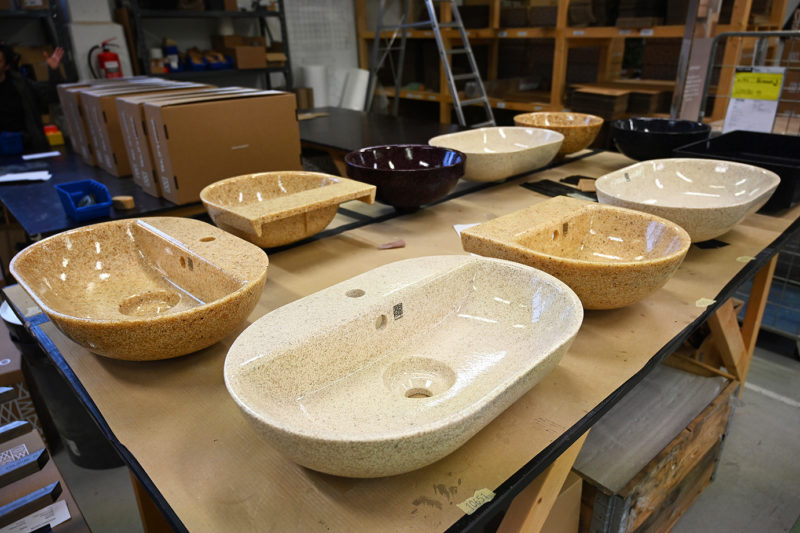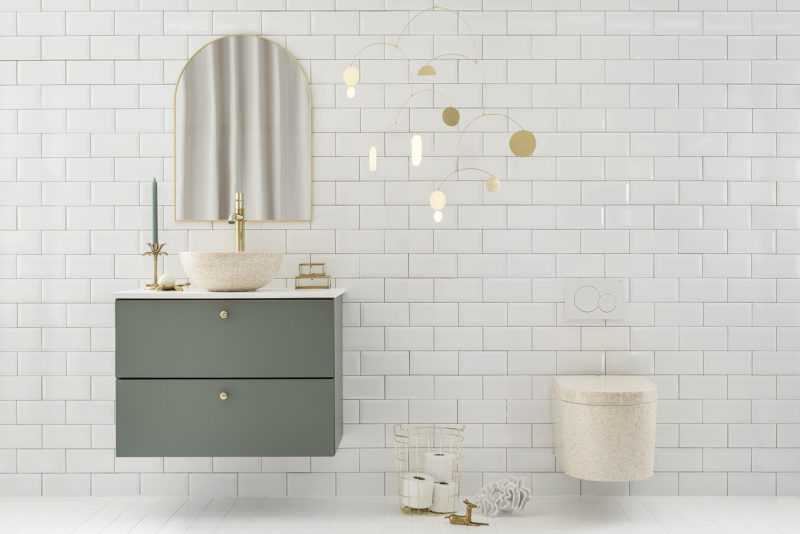Price of wood chips increased 400-fold – design company has at least eight advantages over competitors

The bathroom furniture manufacturer Woodio, a spin-off of university research, is about to take a significant step forward: it is looking for a location for its first industrial-scale factory in the Helsinki area.
According to CEO Petro Lahtinen, Woodio’s philosophy can be crystallised in the ’impossible but inspiring’ claim that ’the future of bathrooms is in wood’.
The conventional thinking is that wood does not like humid environments, but the company has shown by now that this is not necessarily true.
At the core of the company’s activity is a new material, which saw its first beginnings at a Christmas party in the chemistry lab of the University of Helsinki. Various raw materials were mixed together with festive abandon, and in the morning one of the mixtures was found to have solidified intriguingly.
The discovery led to the development of a new material, 80% of which is wood chips. The chips are either made from aspen or come from forest industry sidestreams. The wood material is bound together by a bio-based resin.
The material is used to create a completely new range of washbasins, toilet bowls and bathtubs.
New material outperforms ceramics
Compared to ceramics, traditionally used in bathroom fixtures, the Woodio material has eight advantages: it is light in weight, shock-resistant and recyclable, it is made of renewable materials, its manufacturing requires little energy, it acts as a carbon storage, and it can be produced in a wide range of colours and patterns.
Lightness is an advantage in transport and makes installation easier. As to shock resistance, Lahtinen says he tested this by taking a hammer to the products.
’They just wouldn’t break.’
The ingredients of the material are renewable, and the material can be recycled to make MDF board, for example, or burned for bioenergy.

The manufacturing requires very little energy. The process consists of preparing the moulds for casting, then filling them and allowing the items to dry in room temperature. The mould can be removed in four hours.
After that, the items are cured at low heat, typically 40 degrees centigrade, for a few hours. All that remains then are the finishing and testing.
The carbon footprint of Woodio products is up to 80 percent smaller than their ceramic competitors. Moreover, wood-based products act as a carbon storage throughout their life cycle.
In comparison, ceramic industry consumes a great deal of energy, since the products must be baked at temperatures of up to 1,500 degrees. The ceramic industry globally produces as much carbon dioxide as 200 million cars, and it also causes emissions of sulphur and nitrogen oxides. In addition, it consumes a great deal of drinking water.
The problems caused by ceramics production are widely known. To replace ceramics, materials made of recycled or renewable ingredients are being brought into the market by the Durat and Vieser companies, for example.
Interior design for the house
But how can a wood-based material withstand the permanent humidity of a bathroom? Lahtinen says this is no problem.
Woodio has tested the material by immersing it in water for up to six months, with no adverse effects.
’And it’s not due to any kind of coating. Even pieces with a sawn and untreated surface don’t suffer,’ says Lahtinen.
The material is suitable for mass production, and all products have the same practical properties as ceramic items. They require no extra maintenance.
So far, Woodio has manufactured bathroom furniture, including a range of washbasins, bathtubs, interior panels and, most recently, toilet bowls for customers that include numerous hotels in all parts of Europe. It has bigger plans, though. Lahtinen says that Woodio aims at being the leading eco-material brand in the world.

’We are studying the possibilities of making furniture and interior elements, such as panels, for any room in a house,’ Lahtinen explains.
To expand its production capacity, the company is looking for new facilities in the Helsinki area. Lahtinen estimates that the new production can be started within a couple of years.
However, the expansion is not intended to reduce the price of Woodio products, which is relatively high.
’We aim to keep Woodio as a top-end brand. One way of describing the brand value is that the value of aspen chips multiplies by 400 in our products,’ Lahtinen says.
’Still, that doesn’t mean that we can’t conclude agreements with other brands, such as Ikea or Ido, for the use of our material. They, of course, can price their products as they see fit,’ Lahtinen says.
Customers in 26 countries
Woodio was founded in 2016, as a spin-off of research at the chemistry laboratory of the University of Helsinki, with the purpose of developing and commercialising the material. The first products came on the market in 2019. At the moment, the company has customers in at least 26 countries.
The company currently employs 33 people. The operation has been funded, among others, by the Paasikivi family, main owners of the faucet manufacturer Oras; the Metsä Spring innovation company of the Metsä Group; the European Union and Business Finland. The company’s turnover in 2021 was EUR 350,000, and the estimated figure for this year is EUR 600,000.
’In our present facilities we can reach a turnover of something like two million. In the new factory our production capacity can be tenfold, and we can employ dozens of new people. But that does require that we succeed in negotiation funding for a seven-digit figure,’ Lahtinen says.
